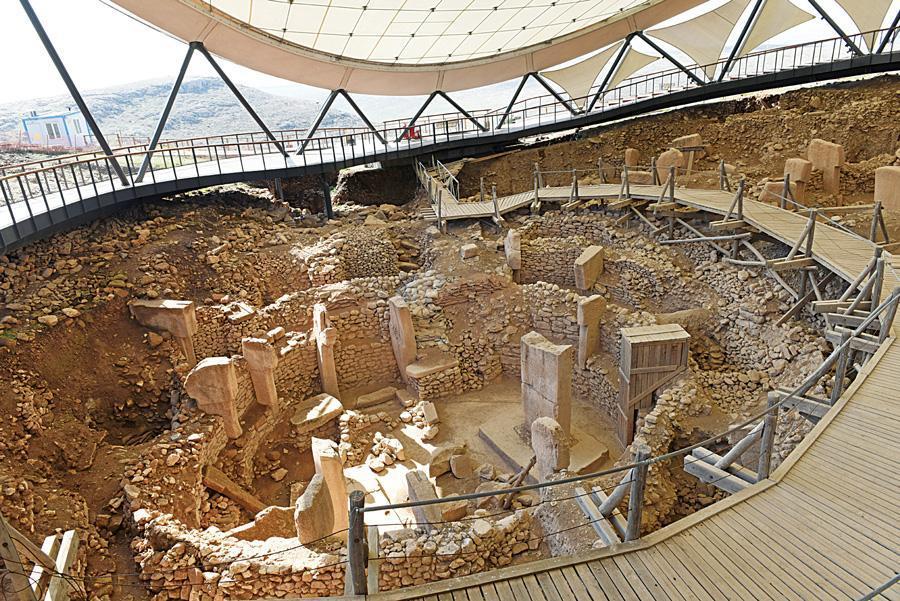Göbeklitepe that altered history
Melih Uslu

Anatolia has been a popular region for settlement throughout history due to its geopolitical location and fertile lands. Humanity, on the other hand, has consistently built places of worship from past to present. Early periods of civilization are currently being rewritten with Göbeklitepe – home to the oldest known temple in the world.
Göbeklitepe, 22 kilometers north of Şanlıurfa, is 7,000 years older than England’s Stonehenge and 7,500 years older than the Egyptian pyramids. This archaeological site, dating back 11,600 years, has shaken to their foundations scientists’ ideas on the origin of civilization since the excavations were launched in 1995 and has prompted us to reinvestigate numerous facts.
[HH] Permanent settlement with belief
Home to the oldest temples discovered to date, Göbeklitepe was built during the last stage of humanity’s transition to agriculture and stock breeding. Starting off from the fact that the region is ancient, the idea that agriculture led to civilization has lost validity. The general view until today was that complex societies were formed as a result of surplus of crops grown after hunter-gatherers settled.
Göbeklitepe opened this popular opinion up to discussion. Archaeologist Professor Klaus Schmidt, who led the excavations for 19 years from 1995 onwards, propounded that the chronological flow of humanity attained a history with Göbeklitepe.
According to Schmidt, the work force required to build structures led to development of agriculture as a way of providing workers with provisions. The crowded communities had a desire to be near places of worship and as resources in the environment were insufficient to meet the needs of these communities, people were forced to engage in agriculture. In the building complex discovered at Göbeklitepe, there was no trace of a roof, and these buildings were recognized as open-air temples.
Göbeklitepe dates back to earlier than the beginning of agriculture and even the invention of pottery. On the other hand, there is a style that can be perceived as artistic in animal figures that embellish T-shaped stones symbolizing man.
On the stones are scorpions, fox, bull, snake, wild boar, lion, pike and mallard figures. Particularly lion figures prove that lions lived in Anatolia during the Neolithic period. According to some researchers, these animal figures symbolize the tribes who visited the temple. The findings at Göbeklitepe illustrate the organizational skills which brought together crowded groups and advanced artistic skills. Symbols similar to those discovered - although smaller - can be seen in a region spanning over Northern Iraq and Syria. Based on this, it is suggested that Göbeklitepe was a center of cultural interaction in the Neolithic period. The fact that the temple floors were constructed in a way to prevent leakage indicates that liquid substances were used in ceremonies. Göbeklitepe was a cult center until around 8,000 BC. However, it was covered with soil and vanished from history, which impels us to vigorously ask the question: “But why?
It is not yet known who designed and built the temples at Göbeklitepe. Nor has the mystery been solved of how these structures were conceived 12,000 years ago in an age when humans were hunter-gatherers and the concepts of settlement and agriculture were as yet unknown. Some archaeologists speculate that this hunter-gatherer community was organized around a shamanic order, in other words, that a shaman or religious leader was behind the entire organization.
Another view is that the existing shamanistic leaders had already been transformed into a special priestly class like that we know from Ancient Egypt. This view holds that socialization took place far earlier than the scientific data have indicated up to now and that human beings were organized according to specific classes in a hierarchical order.
Göbeklitepe is one of the most momentous discoveries in the world of archaeology, the first site to show that hunter-gatherer societies believed not yet to have made the transition to urban life, nevertheless, built temples. It is also a revolutionary find in the history of urbanization, in other words, civilization.
[HH] Schmidt’s Traces
Schmidt, who undertook the excavation expressly because of this discovery, once said: “The temple came first, then the city.” In the process, Schmidt opened up a new chapter in the history of early civilization. Who knows? Perhaps human history will be written all over again once answers are found to these questions.
Another interesting sight I came across was the mesmerizing Şanlıurfa Archaeology Museum, opened in 2015 in a stunning new building. Arranged chronologically into separate spacious halls, the museum’s collection is sure to catch the attention of young and old. In addition to the artifacts excavated from Göbeklitepe, it also displays archaeological findings from Nevali Çori, another archaeological site in the region, which belongs to the Neolithic age and was buried under a dam in 1992.
Şanlıurfa and its periphery stand out among the destinations I visited –in Turkey and abroad– with the magnificent Göbeklitepe Archaeological Site, the historic city center, unique atmosphere that preserves tradition but adopts modern life, and of course, the local cuisine. On my flight back home, I started making immediate plans to return.
















